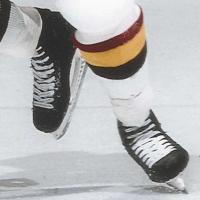Slate
Blackcurrant
Watermelon
Strawberry
Orange
Banana
Apple
Emerald
Chocolate
Marble
Slate
Blackcurrant
Watermelon
Strawberry
Orange
Banana
Apple
Emerald
Chocolate
Marble
-
Content Count
2676 -
Joined
-
Last visited
-
Days Won
72 -
Feedback
0%
Content Type
Profiles
Forums
Downloads
Gallery
Store
MSH News and Articles
Everything posted by flip12
-
FT6 looks like Microsoft Windows.
-
Depends on what your definition of P14 is… •P14 in CCM = PM9: flatter rocker than most. •P14 in Bauer is a very rockered blade. Closer to P28 style than P92. If you don’t like much rocker run in the opposite direction.
-
707s allow you to lock in the talus, crucial to heel lock, while the top 3 eyelets can be as tight or as loose as you please. The problem for most skaters is they panic as soon as there’s the slightest bit of give in that hinge area, so most newer boots lock it down with extra depth and stiffness. JetSpeeds tended to be on the softer side in that regard (I’m not super familiar with more recent iterations of the JS Fam) but still nowhere near a 707.
-

CCM Super Tacks X Total Custom helmet
flip12 replied to shoot_the_goalie's topic in Ice Hockey Equipment
Is their policy (“protocol” might fit better) to test helmets that are too big? Where do they say that? ”Hockey injuries” is a broad category. On the other hand, it’s also narrower than the scope of the Hockey STAR rating system when it comes to cumulative brain impact: when most people talk about brain protection in hockey, they talk about concussions. Hockey STAR isn’t just modeling exposure to concussion-inducing impacts, they model the probable exposure to brain trauma at a given level of hockey (depending on age, competitiveness of the league, etc.) The research on the impact of brain trauma on athletes lives is all relatively new, but it seems concussions get all of the attention and overall brain trauma isn’t even considered in the popular discourse; hence the chestnut, “you don’t even have to hit your head to get a concussion, so these ratings are meaningless.” That’s like saying birth control isn’t 100% effective so there’s no point in seeing how effective various methods are, to the best of our knowledge. I agree with almost everything you say in your second paragraph. I don’t think the problem you outline is particular to this lab’s work, but rather the crux of the issue in the interface between research and the rest of the world. Research often involves much more nuance than the general public and its information disseminating apparatuses tend to have a taste for. This slants the public representation of a lot of research results towards tidy boxes that are crude reflections of the dynamics at play in the raw material, and rewards researchers whose production lends itself to crude boxing. The financial mess entailing that boxing function is a ferocious beast. -

CCM Super Tacks X Total Custom helmet
flip12 replied to shoot_the_goalie's topic in Ice Hockey Equipment
Are you sure they aren’t getting the same snugness they would in the smaller size? Another possibility is they’re erring on the side of best possible rating for a given helmet model. A larger helmet that’s mostly closed will have more shell overlap and more mass overall than a smaller helmet of the same model that’s mostly open, once both sizes are adjusted to the same head circumference (mass won’t change but the degree of overlap will). Both shell overlap and greater mass would contribute positively to impact dissipation. -

CCM Super Tacks X Total Custom helmet
flip12 replied to shoot_the_goalie's topic in Ice Hockey Equipment
Is it a bad thing if they opt for the bigger of two possible fits? No one would read all of that if they had a breakdown of fitting each helmet. As it is now their work is too long for most people to read, judging by the accuracy of the bulk of the critique their work gets. -
Now that you mention it, True has had significant problems with straight Shift holder + steel combos. I wonder if the shell's underbelly still causes issues even for the narrower Shift holder.
-

CCM Super Tacks X Total Custom helmet
flip12 replied to shoot_the_goalie's topic in Ice Hockey Equipment
You're right in that helmets can't protect against whiplash. But that's not to say there isn't substantial impact to the head where helmets can play a part in minimizing the damage, both to the skull and its contents. No helmet is concussion proof. But they are not created equal in how much they dissipate the impact to the head either. Re: the helmet has to fit for it to work discussion, the VT STAR lab actually wrote a whole article talking about the importance of fit when assessing helmet performance in the lab and how that relates to real life: https://www.helmet.beam.vt.edu/publications.html#56 As usual, the story is more nuanced than the popular discussion. Also as usual, it's still not perfect. It never is. -
P46 is a Krepsified (Kreps = P28) E4. Curve wise it's closest to a P92: a heel curve that continues to curve a little less at the toe. It's about the same loft as well. It has a shaved toe but otherwise it's an E4 blade shape. There's not much P88 there except for the fact that they're both on the lower end of the lie scale.
-
A lot of first rounders don’t make it or don’t become stars if they do. I wonder what percentage of first round picks excel in the NHL. Those expectations are quite suspect IMO.
-
A lot of first rounders don’t make it or don’t become stars if they do. I wonder what percentage of first round picks excel in the NHL. Those expectations are quite suspect IMO.
-
Gotcha. I wonder what the flex difference would be. How much does the top of the shaft flex?
-
Have you tried an extension with your tennis handle for your top hand?
-
“It feels so good in hand, it’s insane.”
-
I had the same question. Details buried on PRAUX’s own site (same link as above, section 5) combined with his explanation of th shaft shapes from his Bringing Easton Back video (around 3:15) indicate the Super Round is rounder than Vapor. Rounded Square is the Vapor shape according to the video. It’s not written that clearly on the website unfortunately.
-
You're right, P88 is clearly mislabeled as a 6. Last I lined it up next to P92-Lie 5's, it was actually even lower than that. P46 is a very nice curve. It's an E4, with the toe gradually rockered up to make for more puck-ice-blade contact on toe-fling shots, then with a P92ish curve with a touch more toe. If you line up the P46 and E4 blade faces, it's easy to recognize the shape, just with the material around the toe shaved down a bit. P.S. Warrior Smyth (rumored to be Kovalchuk's legal pattern from the early 2000's) is similar: E4 with a more concentrated toe shave for puck-ice-blade contact on shots, and then that curve which resembles a Sher-Wood Coffey. Forever I was stuck on low lies, so I got to be really picky about these geometric subtleties. I've started to be able to handle a broader range, but haven't ventured as high as the P92 yet.
-
I haven't tried the PRAUX Malkin yet, but I have a couple of Malkin Easton RS Dressed SE16s that look like the could be the same pattern or at least very close. The ones I have don't bear any resemblance to P88, they're very clearly modified E4's. The Ginos I have differ from E4 (PM9) with a little added material making the heel and toe a tiny bit squarer. The curve looks like PRAUX's version: deep toe pocket on a relatively straight blade with a neutral face from heel to mid. Looking at PRAUX's version, it looks so close to mine I just don't get where Geppetty gets P88 from. It's almost like he's afraid of mentioning PM9 unless it's painfully obvious (Crosby). Kovalchuk's another example of a E4 souped up. If you didn't like the lie of P46 (another E4 mod), I'd be wary of the Malkin.
-
Nevermind. I found the answer here: https://prostockhockeysticks.com/pages/stick-school. Still getting used to the new site. There's a lot of information. It's just not well organized.
-
Is there a definitive comparison for Pro's shaft shapes? I'm guessing Square is close to CCM's T shape, but what about the others? What are Rounded Square and Super Round close to? I have some teammates that want to order 70 flexes but I'm afraid they may not like the shaft shape.
-
That’s Danis Zaripov’s stick company заряд (Zaryad): electrical charge. A lot of their earlier sticks had an electrical theme in name and graphics. They're manufactured just outside of Kazan, where Zaripov played most of his career.
-
Pros can also order top-end looking skates with more flex if they wish. PK Subban apparently had really flexible one-piece shell Tacks for instance.
-
New Vapor designs have often been refreshes lately anyway: HyperShite: Mission Pure L7, X: Mission Fly Weight inverted, and so on.



